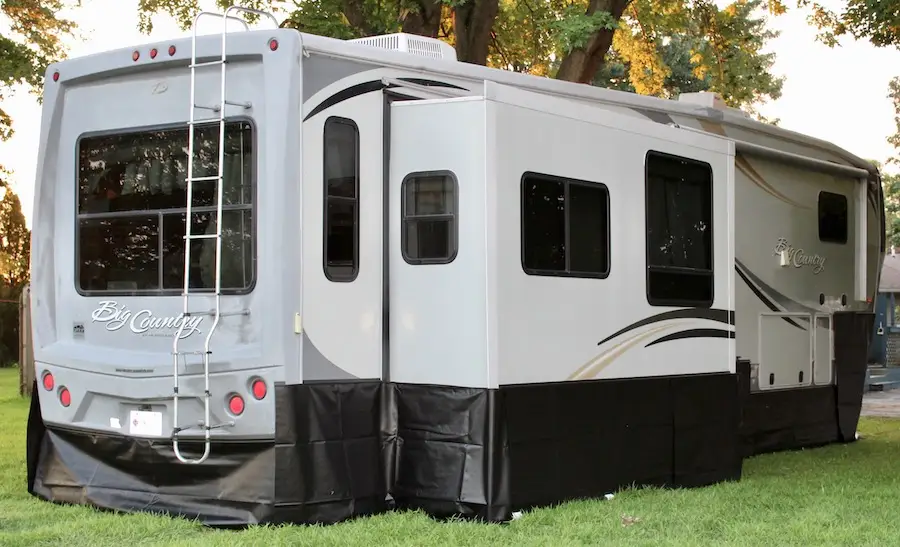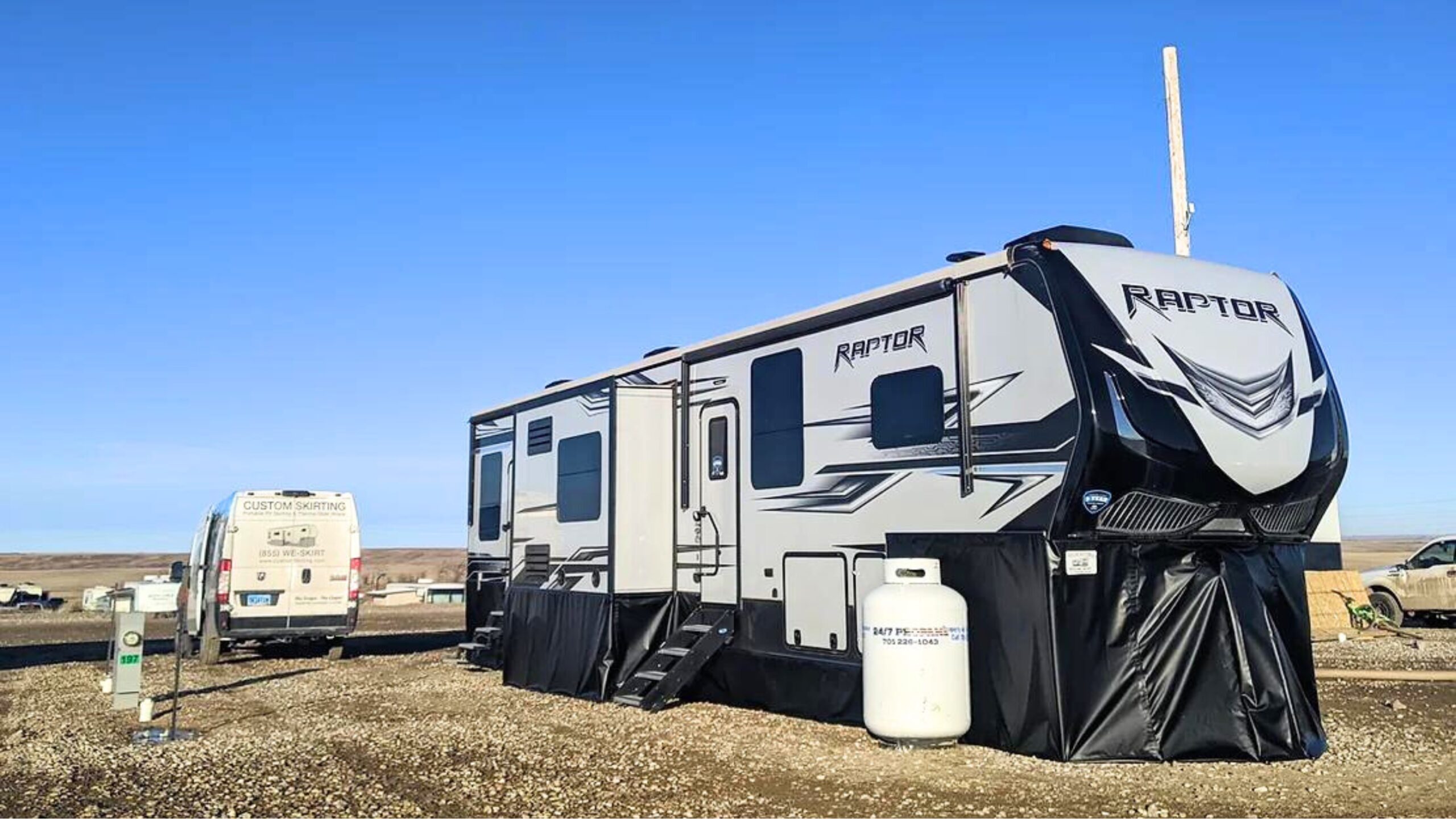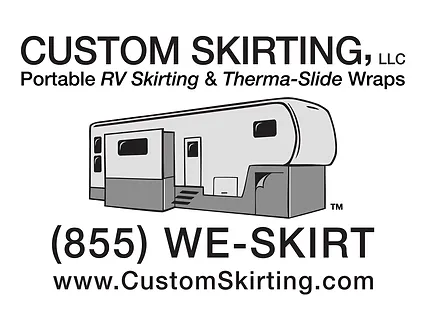
DIY Skirting: Complete Guide
Table of contents
Embarking on the nomadic journey of RV living is an exhilarating adventure, offering the allure of endless horizons and the comfort of a home on wheels. However, as winter descends, the need for a warm refuge within your mobile abode becomes paramount. This guide unfolds the secrets of crafting winter RV skirting ideas and pallet-inspired marvels through RV skirting DIY. It’s not just about insulation; it’s about infusing your unique style into your mobile haven.
In this guide, we delve into the art of DIY RV skirting, blending practicality and creativity to ensure your RV reflects both functionality and personal flair. Explore winter RV skirting ideas that marry warmth with ingenuity, and discover the charm of pallet-inspired solutions that transform your RV into a cozy retreat.
What is RV Skirting?
RV Skirting is a protective barrier designed to enhance the insulation and overall comfort of your home on wheels. This crucial component creates a shield around the base of your RV, acting as a barrier between the exterior environment and the underside of your vehicle. Essentially, it is a tailored enclosure that wraps around the lower portion of your RV, contributing to both practical functionality and aesthetic appeal.
The primary function of RV skirting is to prevent cold air from infiltrating the underside of your RV, ensuring a warmer and more comfortable interior, especially during colder seasons. By effectively sealing off the space beneath the RV, skirting helps in maintaining a consistent temperature inside, reducing the strain on heating systems. This is particularly crucial in winter, where plummeting temperatures can pose challenges to the overall comfort and functionality of your RV.
RV skirting works by creating a barrier that minimizes heat loss prevents drafts, and protects your RV’s plumbing from freezing. It acts as a valuable insulator, not only enhancing the living conditions inside your mobile home but also contributing to energy efficiency. In essence, RV skirting is a practical and versatile solution that plays a pivotal role in creating a comfortable and well-protected environment within your beloved mobile abode.

Why Use RV Skirting?
RV skirting is a game-changer for any avid traveler seeking both comfort and practicality. The use of RV skirting becomes particularly crucial in colder seasons and winter escapades. The primary purpose is to create a protective barrier around the base of your RV, shielding it from the harsh elements and enhancing the overall living experience.
In winter, when temperatures plummet, RV skirting acts as a vital insulator, preventing cold air from seeping underneath the vehicle. This not only keeps the interior warmer but also reduces the strain on heating systems, contributing to energy efficiency (reducing energy costs up to 50%). The benefits extend beyond temperature regulation; RV skirting also plays a pivotal role in safeguarding your RV’s plumbing from freezing, a common concern in colder climates.
Beyond winter, RV skirting proves valuable in various scenarios. During hot summer months, it helps maintain a cooler interior by blocking out excessive heat. Additionally, it acts as a barrier against dust, debris, and pests, ensuring a cleaner and more enjoyable living space. Whether you’re navigating chilly winters or scorching summers, RV skirting emerges as a versatile and indispensable accessory, elevating your mobile home experience with enhanced insulation, energy efficiency, and overall comfort.
Advantages and Disadvantages of RV Skirting Materials
RV skirting DIY materials play a pivotal role in enhancing the comfort and protection of your mobile home. Let’s explore the advantages and disadvantages of popular materials:
- Plywood or Particle Board:
- Advantages: Sturdy and durable, providing solid protection.
- Disadvantages: Heavy, adding weight to the RV, and may require frequent maintenance due to susceptibility to weathering.
- Not easy to pack
- Does not adjust to the ground every time you move
- Foam Board Insulation:
- Advantages: Lightweight and excellent insulation properties, contributing to energy efficiency.
- Disadvantages: May not withstand extreme weather conditions, potentially leading to wear and tear.
- Not easy to pack
- Does not adjust to the ground every time you move
- Plastic:
- Advantages: Lightweight, weather-resistant, and affordable.
- Disadvantages: Prone to damage from strong winds and may not provide the same level of insulation as other materials.
- Vinyl: One of the Best Materials for RV Skirting:
- Advantages: Durable, weather-resistant, and excellent insulation properties if sealed properly to your RV and the ground.
- Disadvantages: Initial cost may be higher, but the long-term benefits, including superior protection and energy efficiency, make it a cost-effective choice.
Choosing the right material depends on factors such as climate, budget, mobility, reuse, and desired longevity. For comprehensive protection and insulation, vinyl stands out as one of the best materials for RV skirting. Its durability and resistance to the elements along with its mobility make it a wise investment, ensuring that your RV remains comfortable and well-protected throughout various seasons and conditions.
How to Do DIY RV Skirting
Now, let’s get our hands dirty and dive into the nitty-gritty of DIY RV skirting. Follow this step-by-step guide to create a customized skirting solution for your RV:
1. Measure and Plan:
- Measure the perimeter of your RV.
- Plan the height and width of the skirting material.
2. Choose Your Material:
- Select the material that best suits your needs and budget.
3. Cutting and Fitting:
- Cut the material to the desired dimensions.
- Ensure a snug fit around the base of your RV.
4. Installation:
- Secure the skirting material in place using appropriate fasteners.
- Pay special attention to corners and edges to prevent gaps.
5. Insulation:
- Consider adding an extra layer for improved insulation if using materials like foam board.
6. Customization:
- Get creative with designs or add personal touches to your DIY skirting.
7. Maintenance Tips:
- Regularly check for wear and tear.
- Address any issues promptly to ensure continued effectiveness.

How Much Does RV Skirting Cost?
The cost of DIY RV skirting can vary based on the materials you choose and the size of your RV. On average, expect to spend anywhere from $500 to $1,000. Depending on your material use and complication of your RV, one can spend several hours and even up to several days installing it. While this initial investment may seem significant, the long-term benefits in terms of energy savings and protection make it a worthwhile expense for any avid RVer.
In conclusion, DIY RV skirting is not just a practical solution; it’s an investment in comfort, protection, and the longevity of your mobile home. So, roll up your sleeves, gather your materials, and embark on the journey of enhancing your RV experience with personalized skirting that reflects your style and meets your specific needs.
Custom Skirting: Your Best Option for RV Skirting
At Custom Skirting we’re a specialized team dedicated to crafting custom RV skirting solutions that redefine protection and convenience. Our patent pending “No-Snap, No-Gap” channel system ensures a precise fit, sealing out water, and snow, and offering superior wind resistance.
Rigorously tested and proven for over a decade, our skirting has endured harsh winters across the northern United States and Canada. Its user-friendly design allows for quick setup by just one person in an hour, and it’s easy to pack up for your next adventure.
When you choose Custom Skirting, you’re choosing unrivaled quality, durability, and convenience for your RV.
